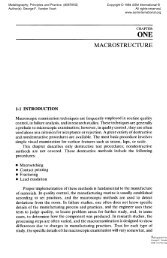Structure/Property Relationships in Irons and ... - ASM International
Structure/Property Relationships in Irons and ... - ASM International
Structure/Property Relationships in Irons and ... - ASM International
You also want an ePaper? Increase the reach of your titles
YUMPU automatically turns print PDFs into web optimized ePapers that Google loves.
166 / <strong>Structure</strong>/<strong>Property</strong> <strong>Relationships</strong> <strong>in</strong> <strong>Irons</strong> <strong>and</strong> Steels<br />
(a) (b)<br />
Fig, 22 TEM micmgraphs of (a) upper ba<strong>in</strong>ite <strong>and</strong> (b) lower ba<strong>in</strong>ite <strong>in</strong> a Cr-Mo-V rotor steel<br />
l<strong>in</strong>ear behavior follows a Hall-Petch type rela-<br />
tionship of (d-l/2).<br />
Most martcnsitic steels are used <strong>in</strong> the tem-<br />
pered condition where the steel is reheated after<br />
quench<strong>in</strong>g to a temperature less than the lower<br />
critical temperature (Act). Figure 36 shows the<br />
decrease <strong>in</strong> hardness with temper<strong>in</strong>g temperature<br />
for a number of carbon levels. Pla<strong>in</strong>-carbon or<br />
low-alloy martensitic steels can be tempered <strong>in</strong><br />
lower or higher temperature ranges, depend<strong>in</strong>g<br />
on the balance of properties required. Temper<strong>in</strong>g<br />
between 150 <strong>and</strong> 200 °C (300 <strong>and</strong> 390 °F) will<br />
ma<strong>in</strong>ta<strong>in</strong> much of the hardness <strong>and</strong> strength of<br />
the quenched martensite <strong>and</strong> provide a small im-<br />
provement <strong>in</strong> ductility <strong>and</strong> toughness (Ref 26).<br />
This treatment can be used for bear<strong>in</strong>gs <strong>and</strong> gears<br />
that are subjected to compression load<strong>in</strong>g. Tem-<br />
per<strong>in</strong>g above 425 °C (796 °F) significantly im-<br />
proves ductility <strong>and</strong> toughness but at the expense<br />
of hardness <strong>and</strong> strength. The effect of temper<strong>in</strong>g<br />
temperature on the tensile properties of a typical<br />
oil-quenched low-alloy steel (type 4340) is<br />
shown <strong>in</strong> Fig. 37. These data are for a 13.5 mm<br />
(0.53 <strong>in</strong>.) diam rod quenched <strong>in</strong> oil. The as-<br />
1 0 0 0 ~ 1800<br />
Ac 3 = 930 °C<br />
900 Fs 1 ! 0 1600<br />
.0o<br />
,oo ?--<br />
° o 6oo "<br />
500 - . . . . -- +<br />
~'E ~ l I I "l\ ~ \1 I I \ ~l~""r I I I ~ ~ I I I X I I I II -1800<br />
200 ~ ~ 400<br />
100 200<br />
0 32<br />
10 102 103 104 105<br />
Seconds I ' ' ' ' I ' ' ' ' I ~ ' ' ~ I<br />
1 10 102 103<br />
M<strong>in</strong>utes I ' I ' ' I ' I<br />
1 4 10 30<br />
Time Hours<br />
Fig. 23 A CCT diagram of a I/2Mo-B steel. Composition: 0.093% C, 0.70% Mn, 0.36% Si, 0.51% Mo, 0.0054% B.<br />
Austenitized at Ac 3 + 30 °C for 12 ra<strong>in</strong>. Bs, ba<strong>in</strong>ite start; B o ba<strong>in</strong>ite f<strong>in</strong>ish; Fs, ferrite start; F o ferrite f<strong>in</strong>ish. Num-<br />
bers <strong>in</strong> circles <strong>in</strong>dicate hardness (HV) after cool<strong>in</strong>g to room temperature. Source: Ref 20<br />
quenched rod has a hardness of 601 HB. Note<br />
that by temper<strong>in</strong>g at 650 °C (1200 °F), the hard-<br />
ness (see x-axis) decreased to 293 HB; or to less<br />
than half the as-quenched hardness. The tensile<br />
strength has decreased from 1960 MPa (285 ksi)<br />
at a 200 °C (400 °F) temper<strong>in</strong>g temperature to<br />
965 MPa (141 ksi) at a 650 °C (1200 °F) temper-<br />
<strong>in</strong>g temperature. However, the ductility, repre-<br />
sented by total elongation <strong>and</strong> reduction <strong>in</strong> area,<br />
<strong>in</strong>creases dramatically. The temper<strong>in</strong>g process<br />
can be retarded by the addition of certa<strong>in</strong> alloy-<br />
<strong>in</strong>g elements such as vanadium, molybdenum,<br />
manganese, chromium, <strong>and</strong> silicon. Also, for<br />
temper<strong>in</strong>g, temperature is much more important<br />
than time at temperature.<br />
Temper embrittlement is possible dur<strong>in</strong>g the<br />
temper<strong>in</strong>g of alloy <strong>and</strong> low-alloy steels. This em-<br />
brittlement occurs when quenched-<strong>and</strong>-tempered<br />
steels are heated <strong>in</strong>, or slow cooled through the<br />
340 to 565 °C (650 to 1050 °F) temperature<br />
range. Embrittlement occurs when the embrit-<br />
tl<strong>in</strong>g elements, antimony, t<strong>in</strong>, <strong>and</strong> phosphorus,<br />
concentrate at the austenite gra<strong>in</strong> boundaries <strong>and</strong><br />
create <strong>in</strong>tergranular segregation that leads to <strong>in</strong>-<br />
tergranular fracture. The element molybdenum<br />
1200 "'"q'e<br />
~-. 1050 ~ ' ~<br />
" 900<br />
.==<br />
¢/)<br />
750<br />
i.~ 600 ~1<br />
eel==,<br />
Ferrite +<br />
peadite<br />
450 Martensites Ba<strong>in</strong>ites ~'~ ', ~* "/45<br />
I I I I ~-'- i i 1-<br />
3OO 4OO 500 600 7OO 8O0<br />
Transformation temperature, °C<br />
Fig. 24 Relationship between transformation tempera-<br />
ture <strong>and</strong> tensile strength of ferrite-pearlite, ba<strong>in</strong>-<br />
itic, <strong>and</strong> martensitic steels. Source: Ref 5
















